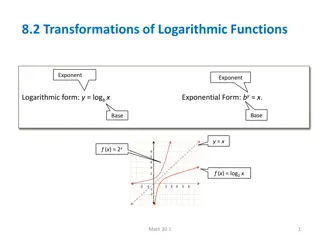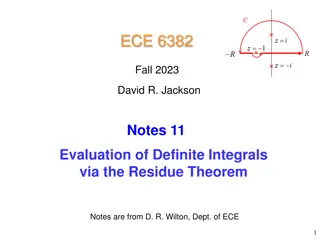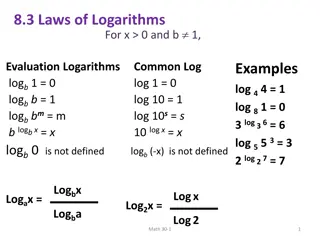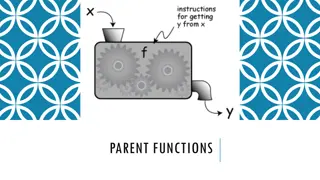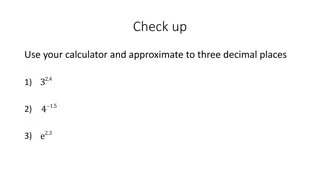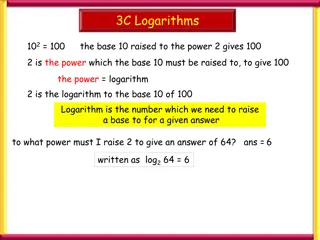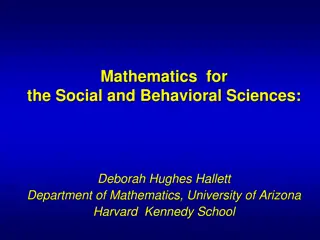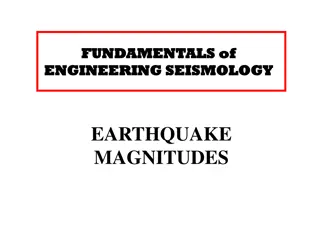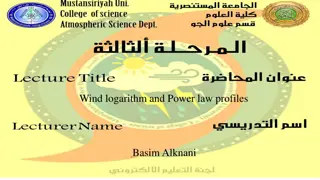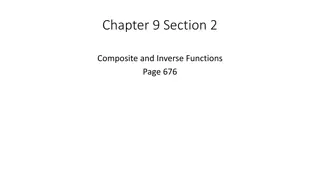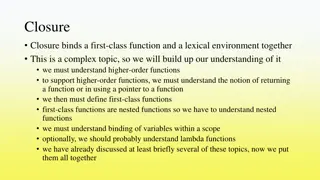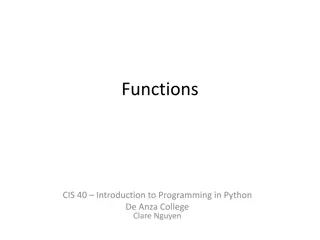Understanding Logarithmic Functions with Examples
Explore logarithmic functions based on the book "Functions, Data, and Models" by S.P. Gordon and F.S. Gordon. Learn about population growth modeling, logarithm definitions, fundamental identities, and solving equations using logarithms. Examples include determining population growth, solving for variables algebraically, and understanding decay models like half-life calculations.
Download Presentation

Please find below an Image/Link to download the presentation.
The content on the website is provided AS IS for your information and personal use only. It may not be sold, licensed, or shared on other websites without obtaining consent from the author. Download presentation by click this link. If you encounter any issues during the download, it is possible that the publisher has removed the file from their server.
E N D
Presentation Transcript
Logarithmic Functions All slides in this presentations are based on the book Functions, Data and Models, S.P. Gordon and F. S Gordon ISBN 978-0-88385-767-0
Example 1 Consider the population of Niger, growing at rate 3.4% per year (one of the fastest in the world) ? ? = ?0 (1.034)?= 11.4(1.034)? p. 2
Population growth of Niger - Graph Assume that the population in Niger continues to grow at the same exponential rate r = 0.034 for the next 80 years after 1999. Then we can graph the function ? ? = 11.4(1.034)? for t from 0 to 80 When will the population of Niger reach 18 million? This exponential function is strictly increasing so for we know that there is exactly one time value for which P(t) = 18. How to find it algebraically? ? ? = 11.4(1.034)? = 18 we need to solve this equation for t p. 3
Definition of Logarithm with Base 10 log1000 = ???103= 3 log1,000,000 = ???106= 6 log0.01 = ???10 2= 2 because 10 2= 0.01 log600 = 2.7782 because 102.7782 600 Definition: ?????? = ? means ???= ? The logarithm with base 10 is that power of 10 needed to produce x. We normally simply write log x when we have a log with base 10. Remember 10?> 0 so x > 0 is the domain of the log function. Fundamental Logarithmic-Exponential Identities ??????= ? ??? ??? ???? ?; ????? ?= ? ??? ? > ? p. 4
Example solving equations using logarithms We use logarithms to solve equations of type ??= ?, where b and C are constants Basic property of log: ?????= ? ????,? > ? Example 1 Solve for x algebraically in the equation 3?= 8 Solution 3?= 8 log3?= log8 log3?= ? log3 = log8 ? log3 log 3 =log8 log3 ? =log8 log3 1.893 We can check our result by plugging in the original equation 31.893 8.0018 p. 5
Example solving equations using logarithms Example 2 Determine algebraically when the population of Niger will reach 18 million. Solution ? = 11.4(1.034)?= 18 18 11.4 1.034?= log1.034?= log 18 11.4= log1.579 t log1.034 =log1.579 ? =log1.579 log1.034 13.662 Niger s population will double in about ??? ? years. p. 6
Example solving equations using logarithms Example 3 Determine the half life of ibuprofen in blood given it follows the decay model ?(?) = 400(0.70)? Solution 400(0.70)?= 200 ? ?? 0.70?=200 400= 0.5 log0.70?= log 0.5 t log0.70 =log0.5 The level of ibuprofen in your blood will drop by half in just under two hours. log0.5 log0.70 1.943 ? = p. 7
Behavior of the Logarithmic Function Some questions: What is the domain? What is the range? For what values of x is the function increasing (decreasing)? For what values of x is the function concave up (concave down)? log 0.001 = -3; Why? log 0.01 = -2; Why? log 0.1 = -1; Why? log1 = 0,? ?? log 10 = 1; Why? log 100 = 2; Why? log 1000 = 3; Why? ? = ???10? p. 8
Additional Properties of Logarithms 1. log ??= ? log? (extract a variable form the exponent) 2. log ? ? = log ? + log? (product rule) 3. log ? = log? log? (quotient rule) ? log 5 9 = log5 + ???9 log 1000? = log1000 + log? log 7/4 = log7 ???4 log 100/? = log100 log? = 2 log? Examples: Note: Is log 7/4 = log 7/ log 4 true? How about log 100/log 6 = log 100 - log 6? Is log (A+B) = log A + log B true? Check for example log (3 + 8) is it equal to log 3 + log 8? p. 9
Comparing Exponential and Logarithmic Functions What is the relationship between ? = log? and ? = 10?? Let's graph them What do we observe? p. 10
Modeling with Logarithms Many applications of logarithms arise in chemistry. pH value, or simply pH measures how acidic a water solution is. The formula is: ?? = log( ??????? ??? ?????????????) Example The hydrogen-ion concentration of pure water is 10 7moles per liter, so the pH is ?? = log 10 7= 7 log10 = 7 1 = 7 ????????log ??= ? log( ?) p. 11
Modeling with Logarithms Example 1 Orange juice, which is somewhat acidic, has a hydrogen-ion concentration of 2 10 4moles per liter. Find the pH value. Solution: ?? = ??? ? ?? ? = (??? ? + ???(?? ?)) = ??? ? ???(?? ?) = ??? ? ( ?)???(??)) = ?.??? + ? ? = ?.? p. 12
Earthquakes and the Richter Scale The Richter Scale is based on the idea that there is a minimum threshold, level of earthquake intensity, denoted by ??. The energy involved in a threshold level earthquake is approximately equal to the energy released by 10,000 atomic bombs. The Richter scale relates the magnitude R of a quake to its intensity Q based on the formula: ? ?? The largest recorded earthquake, which occurred in Chile in 1960, had a magnitude R = 9.5 on the Richter scale. ? = ??? p. 13
Earthquakes and the Richter Scale The largest recorded earthquake, which occurred in Chile in 1960, had a magnitude R = 9.5 on the Richter scale. ? ?0 ? = log = 9.5 ? ?0 = 109.5 ? ?0 = 3,162,277,660 This quake had an intensity more than 3.1 billion times greater than the threshold level. p. 14
Earthquake Example Example 2 How does a magnitude 6 earthquake on the Richter scale compare to a magnitude 5 earthquake? Solution If R = 5 we have If R = 6 we have ? ?0 ? ?0 ? = log = 5 ? = log = 6 ? ?0 ? ?0 = 105 = 106 ? ?0 ? = 100,000?0 ? ?0 ? = 1,000,000?0 = 100,000 = 1,000,000 The intensity of a magnitude 6 earthquake is 10 times greater than the magnitude 5 earthquake. p. 15
Sound Decibels There is a minimum threshold level of sound that can be heard by a human being, denoted by ?0 If the intensity of a particular sound is S, the magnitude d of the sound, measured in decibels, is defined by ? ?0 ? = 10 ??? p. 16
Sound Decibel Example Example 3 How much more intense is the sound level of a normal conversation with a decibel level of d = 60 compared to a threshold level? Solution If d = 60 we have ? ?0 ? = 10log = 60 ? ?0 log = 6 ? ?0 = 106 ? = 106?0= 1,000,000 ?0 The intensity of normal conversation is 1,000,000 times the threshold level. p. 17


